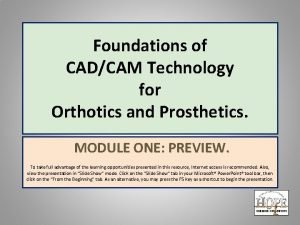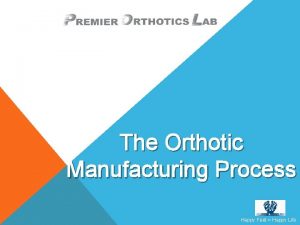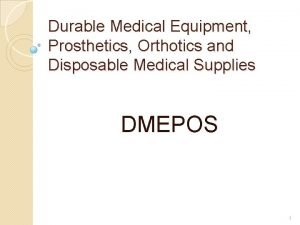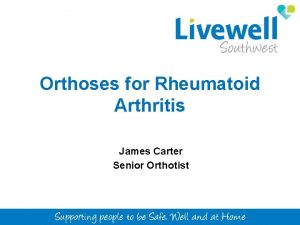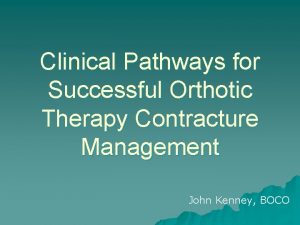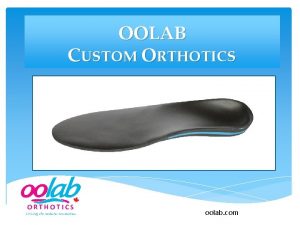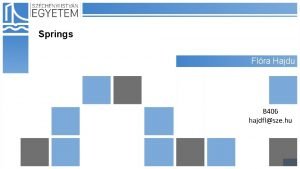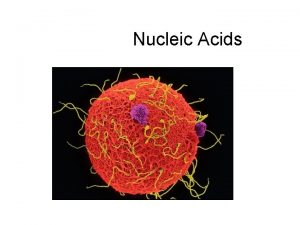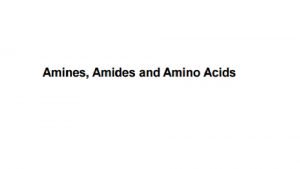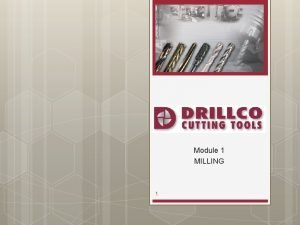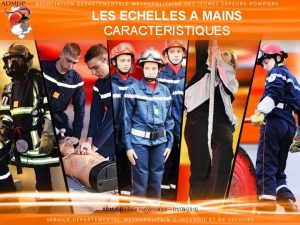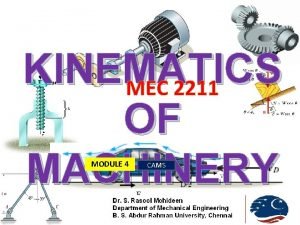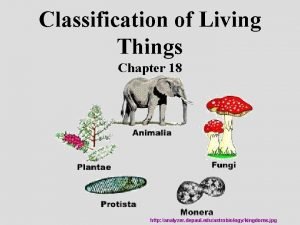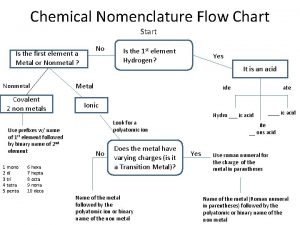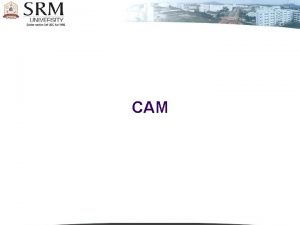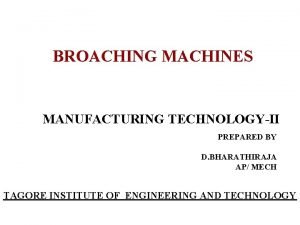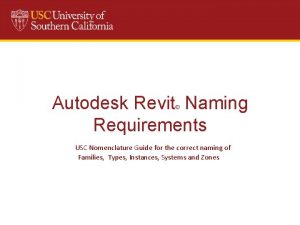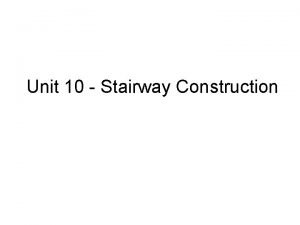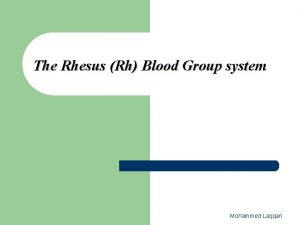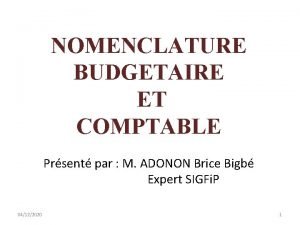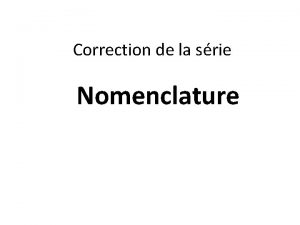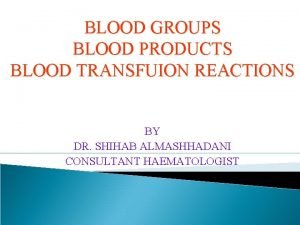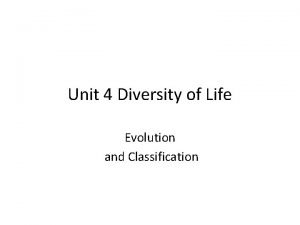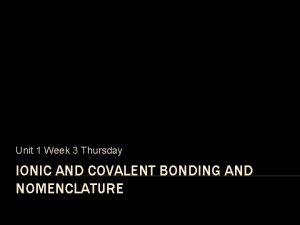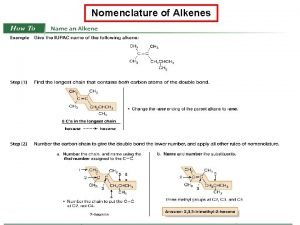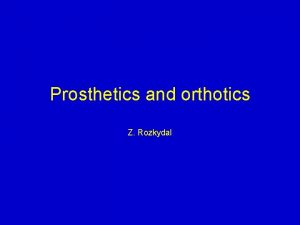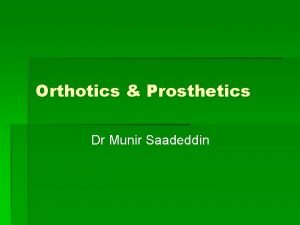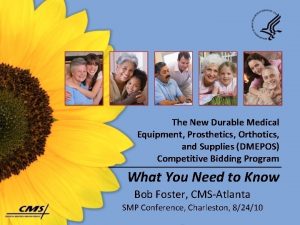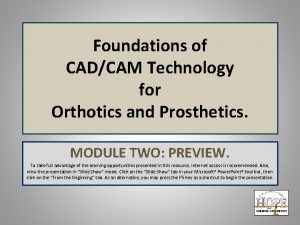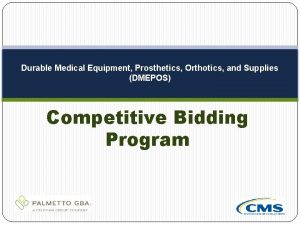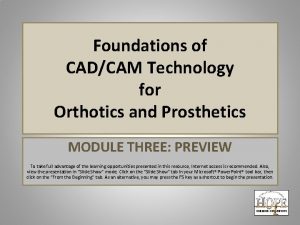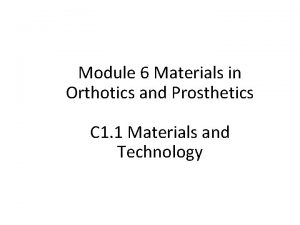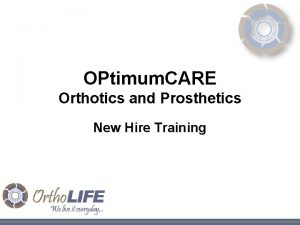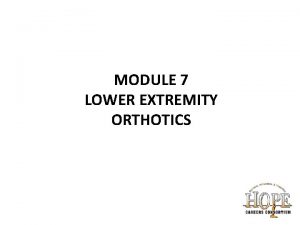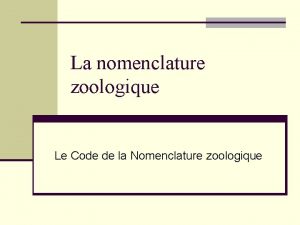INTRODUCTION TO ORTHOTICS Nomenclature of Orthotics prosthetics apart





















































































- Slides: 85


INTRODUCTION TO ORTHOTICS

Nomenclature of Orthotics & prosthetics apart from ISO terminologies; general terms used all over the world suggested by American board of certification in orthotics and prosthetics • ABC – American Board for Certification in Orthotics & Prosthetics • Abduction – The act of moving the hip/shoulder (and residual limb) away from the midline of the body. • Adduction – The act of moving the hip/shoulder (and residual limb) toward the midline of the body. • Extension – The act of moving the hip (and residual limb) backward • Flexion – The act of moving the hip (and residual limb) forward or to the front of the body. • Orthosis – Custom-fabricated or custom-fitted brace or support designed to align, correct, or prevent neuromuscular or musculoskeletal dysfunction, disease, injury, or deformity. • Prosthesis – Artificial medical device that is not surgically implanted which is used to replace a missing limb or appendage such as artificial limbs, hands, fingers, feet or toes. • Residual Limb – Remaining portion of the limb after amputation. • Sound side leg – Non-amputated limb. • Fabrication – Procedure of mechanically creating a device.

Orthosis prosthesis

Continue……………… • Amputation – taking away of a body extremity by surgery or trauma. • Bulbous – Refers to the residual limb being larger in circumference at the end than at the top. • Functional Level – Degree of function a disabled patient still achieves. • Gait – Walking. • Thoracic – Related to the trunk/rib cage. • Hemipelvectomy – A high-level pelvic amputation. • Hip Disarticulation – Amputation of the entire leg from the hip. • Syme’s amputation – An amputation performed at the ankle joint • Transfemoral – A type of amputation that occurs above the knee. • Transhumeral – A type of amputation that occurs above the elbow. • Transradial – A type of amputation that occurs at the forearm. • Transtibial – A type of amputation that occurs below the knee.


Hemipelvectomy/ hip disarticulation

Syme’s amputation, transfemoral , transtibial

Transradial tanshumeral

Continue……………… • Socket – The portion of the prosthesis that is in contact with the residual limb. • CO (Certified Orthotist) – Orthotist who has passed the certification standards of The American Board of Certification in Orthotics & Prosthetics, and maintains certification through mandatory continuing education program and adherence to the Canons of Ethical Conduct. • CP (Certified Prosthetist) – Prosthetist who has passed the certification standards of The American Board of Certification in Orthotics & Prosthetics, and maintains certification through mandatory continuing education program and adherence to the Canons of Ethical Conduct. • CPO (Certified Prosthetist-Orthotist) • Corset – Lumbar brace made from textile material.

Socket

Continue………… • Cervical – Pertaining to the neck. • Custom Fabricated Orthosis – Orthosis, which is individually made for a specific patient. Created using an impression generally by means of plaster or fiber cast, a digital image using computer-aided design-computer aided manufacture (CAD-CAM) systems software, or direct form to patient.

Continue……………… • Orthopaedics – Medical specialty dealing with the locomotor system. • Orthopaedist – Surgeon who corrects congenital or functional abnormalities of the bones with surgery, casting, and bracing. • Orthotics – The science and practice of evaluating, measuring, designing, fabricating, assembling, fitting, adjusting, or servicing an orthosis under a prescription from a licensed physician, physical therapist, chiropractor, or podiatrist to correct or alleviate neuromuscular or musculoskeletal dysfunction, disease, injury, or deformity. • Orthotist – Person who measures, designs, fabricates, fits, or services orthoses as prescribed by a licensed physician, and who assists in the formulation of an orthosis to support or correct disabilities. • Pedorthics – Design, manufacture, fit and/or modification of shoe and foot orthoses to alleviate foot problems caused by disease, congenital condition, overuse or injury.

Continue……………… • Prosthetics – Science and practice of evaluating, measuring, designing, fabricating, assembling, fitting, adjusting, or servicing prosthesis under an order from a licensed physician/physical therapist. • Prosthetic Components – The parts that make up the artificial limb. For example, foot, ankle, socket, pylon, etc. • Prosthetist – Person who measures, designs, fabricates, fits, or services prosthesis as prescribed by a licensed physician, and who assists in the formulation of the prosthesis prescription for the replacement of external parts of the human body lost due to amputation or congenital deformities or absences. • Pylon – Pipe-like structure used to connect the prosthetic socket to the foot/ankle components.

pylon

Continue……………… • Definitive Prosthesis – The permanent prosthesis (usually provided after a preparatory/temporary) that is designed to last for several years. • Alignment – The relationship of the prosthetic foot to the socket. • Doffing – Taking the orthosis or prosthesis off. • Donning – Putting the orthosis or prosthesis on. • Dystrophy – Pathologic loss of muscle mass. • Edema – Swelling of the tissue. • Endoskeletal Design of prosthesis– A construction technique that uses a pipe or pylon as the support structure. This design allows for the exchange of components and adjustment. An endoskeletal system can be covered with a cosmetic foam that is shaped to match the sound side limb. • Exoskeletal Design of prosthesis– A construction technique that uses wood or hard foam as the support structure. This prosthesis is identified by its hard external finish.

Continue……………… • Physical Therapist (PT) – A trained professional who performs and teaches exercises and other physical activities to aid in rehabilitation and maximize physical ability with less pain. PTs teach the amputee exercise techniques, gait training and ways to navigate physical barriers with a prosthesis. • Plaster Impression – The plaster cast that is applied to the residual limb in order to obtain an accurate model during the fabrication process. • Prefabricated Orthosis – which is manufactured in quantity without a specific patient in mind, which may be trimmed, bent, molded, or otherwise modified for use by a specific patient. • A preformed orthosis is considered prefabricated even if it requires the attachment of straps and/or the addition of a lining and/or other finishing work • Any orthosis that does not meet the definition of a custom fabricated orthosis is considered prefabricated. ,

Continue……………… • Soft Orthosis – Orthotic device made from fabric or elastic components (e. g. , pressure gradient hose, corset, cervical collars, ). • Rehabilitation – Process of restoring a person who has been debilitated by a disease or injury to a functional life. • Rehabilitation Team – Group of allied health care professionals that frequently includes physician, surgeon, orthotist/prosthetists, physical and occupational therapist, social worker and counselor who serve the needs of a patient.

Physical therapy • Use of prostheses and orthoses to improve human function. Physical therapists (PTs) examine patients/clients, evaluate data to make clinical judgments, diagnose to determine the impact of the problems on function, and then select and implement appropriate interventions. • Determining the need for prostheses or orthoses, working closely with prosthetists and orthotists in selecting appropriate components, and teaching patients and families the proper use and care of the devices are integral parts of these functions. Physical therapists’ assistants (PTAs) work with the physical therapists in carrying out selected interventions and must also understand the fit and function of such devices. • To fulfill these functions, the student must learn the different types of devices, their biomechanical principles, how they should be properly fitted, and how to teach clients the proper use and care of all devices. Today’s growing technological advances have led to a great variety of currently available simple and complex devices, and continued research and development lead to new components and capabilities.

HISTORY OF ORTHOTICS • People have been wearing shoes for many centuries. Early shoe designs dating back thousands of years suggest that appearance has always been as important as comfort; in early times, wearing shoes was a status symbol as only the rich could afford them. • As materials and artisans became more plentiful and shoes became more affordable, people started to consider comfort as well as style. • Early innkeepers provided travelers with matted animal hair foot covering, and eventually, artisans began to specialize in making shoes. These early cobblers added leather and felt. Responding to customers’ need for adaptations, they began to make pads and inserts to provide more comfort. • A variety of shoes and shoe adaptations followed with the advent of electricity and new equipment. • New materials were developed and universal lasts for different sizes became available for mass production. Cobblers continued to be in demand to make adaptations for comfort and accommodation of deformities

HISTORY OF ORTHOTICS • Concomitant with the development of more sophisticated and adapted shoes came the development of splints and braces to support damaged limbs. Skilled metal workers, not only made prosthetic devices for those who had lost a limb but also made supportive devices for people with fractures and other injuries. • Brace makers eventually became the orthotists of today. • In the 18 th century, the French physician Nicolas Andry suggested that a body’s misshape did not have to be permanent, particularly in children. He suggested that, much like a gardener who ties a misshapen tree to correct the shape, devices could be developed to correct a misshapen spine or limb so that, with growth, the deformity could be corrected. • As in prosthetics, the greatest improvements in the orthotics came in the 20 th century after both world wars and the polio epidemics of the late 1940 s and early 1950 s. Manufacturers, orthotists, orthopedists, and others involved in the rehabilitation of the severely disabled began to use and adapt the now wide array of prefabricated parts into functional orthoses for specific purposes.

AMPUTATION SURGERY THROUGH THE AGES • Early amputations were only performed because of trauma or gangrene. Hippocrates (450– 377 BCE) advocated performing amputation because of gangrene and cutting through “dead” tissue. • Bleeding was controlled with cauterization. The emphasis was on surgical speed rather than shaping the residual limb. Many did not survive the shock of the amputation or the postoperative infections that frequently followed. Over the next decades, surgical techniques continued to improve and amputations were performed for chronic ulcers, tumors, and congenital deformities. • Ambroise Pare (1510– 1590), a French army surgeon, reintroduced the use of ligatures, originally set forth by Hippocrates. This technique was more successful than crushing the amputation limb, dipping it in boiling oil, or other means of cautery that had been used during the Dark Ages to stop bleeding. Pare was the first to describe phantom sensation. • General improvements and development in surgical techniques which continued through the centuries contributed to improvements in amputations, survival, and eventually residual limb preparation.

AMPUTATION SURGERY THROUGH THE AGES • The relationship between the residual limb and the prosthetic socket is critically important in the person’s eventual ability to functionally use a prosthetic device. • With improved control of bleeding followed by the introduction of anesthesia, surgeons could begin to look at other surgical techniques rather than the standard cutting of the limb at one level, usually above the knee. • James Syme of Edinburgh performed the first successful amputation at the ankle joint in 1842; the procedure carries his name. He also advocated thigh amputations through the cortical bone of the condyles or the trochanters. • In 1867, Joseph Lister published his principles of antiseptic surgery that markedly reduced mortality during and after surgery. • Lister also experimented with catgut as a ligature (1880) rather than silk or hemp that were not absorbed by body tissues and often caused inflammation and hemorrhage. • These developments were all precursors to the improved surgical approaches to amputation that came in the 20 th century.

Prosthetic sockets:

The 20 th Century • In the early 1900 s, surgeons attempted to build bone bridges at the ends of transtibial (below-knee) amputations to allow for greater end bearing and to reduce breakdowns at the end of the residual limb. Traditionally, severed muscles were allowed to retract, and eventually, bone ends pushing against the distal skin of the residual limb in the openended sockets of the times caused pain and ulcerations. • World War I with its 4200 U. S. amputations and almost 100, 000 amputations in all armies led to improved skin flaps and greater consideration for levels of amputation. • It was generally agreed that the middle third of the lower leg and lower to middle third of the thigh were the most ideal length for a residual limb. • World War II led to further improvements in surgical techniques and greater consideration for the shape of the residual limb. • Myoplasty, the suturing of the ends of severed muscles over the end of the bone, was first advocated in 1942 but did not gain in popularity until the 1950 s when it was adopted by Dederich and popularized by Burgess.

The 20 th Century • Myodesis, : the suturing of severed muscles to distal bone, was advocated by Weiss in the 1960 s. Both myodesis and myoplasty are designed to provide muscle fixation for improved function and shape of the residual limb. • In 1958, Michael Berlemont, in France, demonstrated immediate postsurgical fitting of prostheses. • The technique that involves placing the residual limb in a rigid postsurgical dressing fabricated using prosthetic principles was also advocated by Weiss and was brought to the United States by Sarmiento and Burgess. • In the l 960 s and 1970 s, a number of factors combined to lead surgeons to reconsider the transfemoral amputation as the level of choice for severely Ischemic limbs. • Immediate postoperative fitting reduced postoperative edema, allowing healing at transtibial levels, even for individuals with severe ischemia. Improved circulatory evaluation techniques provided accurate information on the presence of collateral circulation. • The use of the long posterior flap with its increased blood supply also contributed to the healing capabilities of transtibial amputations. • All of these factors contributed to a reversal in the number of transtibial and transfemoral amputations performed for severe limb ischemia and concomitantly increased the number of individuals becoming successful prosthetic ambulators.

The Development of Prostheses Through the Ages • Early prostheses were usually made by local artisans or the individual who had sustained the loss. Most lower extremity limbs employed a simple peg with some straps for suspension. Upper extremity limbs were fabricated to hold a weapon or shield. • Prostheses were made of wood or metal as dictated by availability and the preference of the fabricator. In 1561, Pare designed an artificial limb of iron that employed an articulated joint for the first time (Fig. 1. 1). In 1696, Pieter Andriannszoon Verfuyn (Verduin’), a Dutch surgeon, introduced the first known transtibial prosthesis with an unlocked knee joint. • In concept, it resembled the thigh-corset prosthesis used in more recent times. A thigh cuff bore part of the weight and was connected by external hinges to a leg piece whose socket was made of copper and lined with leather. The leg piece terminated in a wooden foot. • In 1843, James Potts of London introduced a transfemoral (above-knee) prosthesis with a wooden shank and socket, a steel knee joint, and an articulated foot with leather thongs connecting the knee to the ankle. This enabled dorsiflexion (toe lift) • whenever the wearer flexed the knee. The device was known as the “Anglesey (Anglesea) leg” because it was used by the Marquis of Anglesey following the loss of his leg in the Battle of Waterloo((Fig. 1. 2).

FIGURE 1. 1. An above-knee artificial leg invented by Ambroise Paré FIGURE 1. 2. The Anglesey (Anglesea) leg (1816) with articulated knee, ankle, and foot. (Left) Below knee. (Right) Above knee.

THE WORLD WARS • During the American Civil War (1861– 1865), interest in artificial limbs and amputation surgery increased because of the number of individuals surviving amputations (30, 000 in the Union army) and the commitment of federal and state governments to pay for artificial limbs for veterans. J. E. Hanger, who lost a leg during the Civil War, replaced the cords of his prosthesis with rubber bumpers at the ankle to control plantar flexion and dorsiflexion. • The J. E. Hanger Company opened in Richmond, Virginia, in 1861, and in 1862 the first law providing free prostheses to people who lost limbs in warfare was enacted by the U. S. Congress. • In 1863, the suction socket (Fig. 1. 3) that employed the concept of using pressure to suspend an artificial limb was patented by an American, Dubois D. Parmelee, who also invented a polycentric knee unit and a multiarticulated foot. • In 1870 Congress passed a law that not only supplied artificial limbs to all honorably discharged persons from the military or naval service who had lost a limb while in the U. S. service, but also entitled them to receive one every 5 years.

FIGURE 1. 3. The D. D. Parmelee prosthesis with suction socket, patented in 1863.

THE WORLD WARS • Fewer Americans (4403) lost a limb during World War I (1914– 1918) compared to the British (42, 000) or to the total number of amputations (approximately 100, 000) in all of the armies of Europe. • However, the war was an impetus for improvements in artificial limb developments. Collaboration between prosthetists and surgeons in the care of veterans with amputations led to the formation of the Artificial Limb Manufacturers Association in 1917. • Little progress was made in the field of prosthetics and amputation surgery in the period between the two wars, but World War II again spurred developments. • The American Orthotic and Prosthetic Association (AOPA) was established in 1949 and developed educational criteria and examinations to certify prosthetists and orthotists. • In 1945, in response to the demands of veterans for more functional prostheses, the National Academy of Sciences (NAS) initiated a study to develop design criteria for artificial limbs that would improve function.

THE WORLD WARS • The Committee on Artificial Limbs (CAL) contracted with universities, industrial laboratories, health providers, and others to spearhead majorchanges in all facets of prosthetics and orthotics. • From 1947 to 1976 under NAS sponsorship and Veterans Administration (VA) support, the CAL, the Committee on Prosthetic Research and Development (CPRD), and the Committee on Prosthetic-Orthotic Education (CPOE) influenced the development of modern prosthetics and orthotics. • Plastics replaced wood as the material of choice, socket designs followed physiological principles of function, lighter weight components were developed, and more cosmetic alternatives were fabricated. • Most modern prosthetic principles had their inception in the work of these committees. • Since the 1970 s, prosthetic developments have grown at an exponential rate. Computer -assisted socket designs, new materials spawned by the space age, better research into human function, miniaturization, and computer chips all have contributed to vastly improve general and specialized prosthetic components.

THE WORLD WARS • Prosthetics and orthotics have emerged as sciences as well as art. The consumer is also making greater demands on the prosthesis, seeking limbs that will enable him or her to participate in all aspects of life, including sports and leisure activities. The Iraq and Afghanistan wars have brought many young people into the world of the amputee; they seek prostheses that will enable them to stay in the military if desired and perform all the physical activities needed for their jobs. • Flexible intimate fit sockets suspended by suction were developed for transfemoral and transtibial amputations. Gel-filled liners provide a shock-absorbing interface between the residual limb and the hard socket. Gel liners insure an intimate fit suspending the prosthesis with virtually no pistoning, making the artificial limb an integral part of the lower extremity. • There a wide variety of prosthetic feet designed to respond dynamically and incorporating multiple axes of motion similar to the human foot. • Research highlighted the importance of swing phase as well as stance phase in normal walking, leading to multiaxis and computer-assisted knee mechanisms.

THE WORLD WARS • Initial development of prototype active feet and knee components are currently in use and close to reaching the marketplace. Researchers are attempting to find a method to bring sensation into the prosthetic limb. • The upper extremity has always posed a major challenge for prosthetists. The great complexity of hand function is difficult to duplicate mechanically. • The loss of sensation limits the function of the hand or hook, and researchers have yet to develop replacement for sensory function. Research in this area is continuing. • Developments in external power and virtual reality are probably the highlight of modern upper extremity prostheses. Myoelectric controls are now used fairly routinely for transhumeral and transradial amputations.

THE 21 ST CENTURY • The 21 st century is bringing many changes in the field of prosthetics and orthotics and in the care of individuals in need of prostheses and orthoses. • Robotics are moving from the realm of science fiction to practical applications. Fairley reported on the development of a lower extremity exoskeleton suit developed at the University of California Berkeley. • The suit weighs about 31 lbs with a battery pack, and a computer allows the wearer to perform activities such as carrying a heavy weight without feeling the weight or tiring. Another suit developed in Japan allows the disabled wearer to perform activities of daily living the person cannot otherwise perform. • This suit detects biosignals generated on the surface of the skin when the person attempts to make selected movements. • Robotic developments in prosthetics seek to create active rather than responsive movements. • The 21 st century will likely bring changes in surgery and reconstruction. Work being done on nerve transplants is already beginning to salvage limbs that otherwise would be nonfunctional and often require amputation. • Virtual reality is increasingly being used for both upper and lower extremity rehabilitation. • .

History: The American Academy of Orthotists and Prosthetists • The American Academy of Orthotists and Prosthetists is dedicated to promoting professionalism and advancing the standards of patient care through education, literature, research, advocacy, and collaboration. • The Formative Years • The American Academy of Orthotists and Prosthetists (the Academy) was founded in November 1970 to expand the scientific and educational attainments of professional practitioners in the disciplines of orthotics and prosthetics. • The leadership of the American Orthotic and Prosthetic Association (AOPA), a trade association serving the interests of orthotic and prosthetic facilities, manufacturers, and suppliers, and the American Board for Certification in Orthotics, Prosthetics & Pedorthics (ABC), the sole U. S. credentialing agency at that time, agreed that there was a need for an organization focused on continuing education.

History: The American Academy of Orthotists and Prosthetists • The Academy is dedicated to: • (1) attainment of the highest standards of technical competence and ethical conduct by its members; • (2) the professional recognition of qualified practitioners; • (3) the assurances that practitioners maintain high standards of professional conduct; and • (4) collaboration with other educational, research, and related organizations in developing technical and ethical standards for orthotics and prosthetics. • In order to fulfill these objectives, Active, voting, membership in the Academy is restricted to individuals who have been certified in orthotics or prosthetics by and who remain in good standing with ABC.

BASIC TERMINOLOGY used for ORTHOTICS AND PROSTHETICS • International terminology standards have been established to facilitate communication and research regarding orthoses and their uses. • The method of describing orthoses by reference to the body segments they encompass is widely accepted • worldwide and now has been complemented by proposals for the classification and description of orthotic components. • A recently approved international standard describing the methods and the terminology to be used to define the clinical objectives and functional requirements of orthoses fosters the development of evidence-based practice worldwide.

Historical background: (International organization for standardization) • The International Organization for Standardization (ISO) is a worldwide federation of national standards organizations, known as ISO member bodies, that has its headquarters in Geneva, Switzerland. • Founded on 23 February 1947, the organization promotes worldwide proprietary, industrial and commercial standards. • ISO has 164 national members out of the 206 total countries in the world • The organization is involved in a wide range of standardization activities embracing virtually every aspect of manufacturing, scientific, and commercial activity. • ISO derives its income from two sources: the fees paid by member bodies and the sales of documents, primarily standards, that it publishes. • Because of this latter funding stream, all ISO documents are protected by copyright, and no part of them can be reproduced without the permission of the publisher.

(International organization for standardization) • Before describing the content of the current ISO standards, it is perhaps appropriate both to pose and to attempt to answer the question, ‘‘Why do we need international terminology standards in orthotics? ’’ An answer might be provided by citing the sentiments expressed in the introductions to some of the more recently published standards. • In the absence of an internationally accepted method of describing either patients being treated (orthotically) or the orthoses and their components being employed, the members of the clinic teams in different countries have tended to develop their own terminology for this purpose. • This situation creates difficulties for practitioners prescribing orthoses and for manufacturers describing their products and has made the reporting of the treatment of particular patient groups and in particular the comparison of the outcomes of orthotic treatment in different centres almost impossible. • The standards described in this chapter permit the systematic and unambiguous description of the patient being treated with an orthosis, the objectives of the treatment, and both the functional characteristics and the

Technical committees and working Groups • The task of developing ISO standards is performed by Technical Committees (TCs) and their Working Groups (WGs). Every member body that expresses an interest in the work of a TC is entitled to be represented on that TC and its WGs. • The process whereby a new international standard is developed and eventually published is complex and lengthy. • A proposal must go through a series of stages, first as a New Work Item Proposal (NWIP), then as a Committee Draft (CD), then as Draft International Standards (DIS), and finally as Final Draft International Standards (FDIS), with opportunities for comment or revision at all stages by the participating member bodies. • The complete process, from the adoption of a new work item until publication, typically takes a minimum of 5 years. • The purpose of describing the ISO committee structure and its method of operation is to make clear that ISO standards development is a closely regulated and controlled process. • The resulting standards genuinely reflect the consensual view of the relevant professional groups.

The standards • One of the first tasks undertaken by WGs at their inaugural meeting in St. Andrews, Scotland, in 1980 was an attempt to define the scope of their future work. • The initial work program of the WGs included two standards of relevance to the field of orthotics: • ISO 8549 -1: 1989 Prosthetics and Orthotics—Vocabulary (General terms for external limb prostheses and external orthoses) • ISO 8549 -3: 1989 Prosthetics and Orthotics—Vocabulary (Terms relating to external orthoses) • The majority of the work performed by the WGs in the succeeding 10 years of the TC’s existence was directed at the field of prosthetics; however, the past 5 years has seen the focus of the. WG program shift in the direction of orthotics, with the resulting publication of two further important standards: • Description of the person to be treated with an orthosis, clinical objectives of treatment, and functional requirements of the orthosis. ” • ISO : 2005: Prosthetics and Orthotics (Classification and description of external orthoses and orthotic Components)

ISO; 1989: Prosthetics and Orthotics—Vocabulary • General terms for external limb prostheses and external orthoses • This first basic step into the world of ISO standardization attempts to define the fields of prosthetics and orthotics, the general terms used to describe prostheses and orthoses, the anatomy of those parts of the body most commonly fitted with these devices, and the personnel and procedures involved in their supply. • The orthotic terms included in this standard are listed in Box 1 -1. An orthosis is defined as ‘‘an externally applied device used to modify the structural and functional characteristics of the neuromuscular and skeletal systems. ’’ • Orthotics is defined as ‘‘the science and art involved in treating patients by the use of an orthosis. ’’ • An orthotist is defined as ‘‘a person who, having completed an approved course of education and training, is authorised by an appropriate national authority to design measure and fit orthoses. ’’


ISO : 1989 Prosthetics and Orthotics—Vocabulary • Terms relating to external orthoses This important standard, based on the pioneering work of Dr. E. E. Harris while working for the Committee for Prosthetic Research and Development (CPRD) in Washington, DC, under the direction of A. Bennett Wilson, categorizes orthoses by reference to the anatomical segments and joints they encompass and establishes a system of abbreviations derived from the initial letters of the English terms for each category. For example, • an ankle–foot orthosis is defined as ‘an orthosis which encompasses the ankle joint and the whole or part of the foot’’ and is referred to by the abbreviation ‘‘AFO. ’’ • A wrist–hand–finger orthosis is defined as ‘‘an orthosis that encompasses the wrist joint, the hand, and one or more fingers’’ and is referred to by the abbreviation ‘‘WHFO. ’’ • A lumbosacral orthosis is defined as ‘‘an orthosis that encompasses the whole or part of the lumbar and sacro-iliac regions of the trunk’’ and is referred to by the abbreviation ‘‘LSO. ’’ • The degree of acceptance of the system of abbreviations internationally.

The full range of devices defined in this manner is listed in Box 1 -2.

Definition of orthosis • The simplest definition of an orthosis is any externally applied device to an existing body part that improves function. • Common goals for orthotic devices include the following: • 1. Stabilize weak or paralyzed segments or joints • 2. Support damaged or diseased segments or joints • 3. Limit or augment motion across joints • 4. Control abnormal or spastic movements • 5. Unload distal segments • To achieve these fundamental goals, special attention must be given to issues such as the biomechanics of the device, durability of the materials used, and, most importantly, tissue tolerance to pressures exerted by the device.

(ISO) 2003: Prosthetics and Orthotics—Functional Deficiencies Description of the person to be treated with an orthosis, clinical objectives of treatment, and functional requirements of the orthosis • This ambitious standard, published in 2003, is intended to provide clinicians with a method of describing in a consistent and unambiguous manner the persons they are treating orthotically, their reasons for doing so, and the conditions the orthosis must create. • The first of the three defined objectives of the standard— the description of the person being treated—is achieved by specifying the method and the terminology to be used to describe the clinical characteristics listed in Box 1 -3. • It should be emphasized that the clinician using this standard would not routinely record all this information, but rather would select those items considered relevant to the particular type of patient and the intended use of the information.


(ISO)2003: CONTINUE……………… • The second goal of the standard is to establish a consistent method of defining what are referred to in the standard as ‘‘the clinical objectives’’ of the orthotic treatment. • Nine basic objectives are identified in Box 1 -4. • For each of these objectives, the information that it recommended to be recorded is specified. • For example, if the objective is to relieve pain, the clinician should record which joints or segments are involved and what induces the pain. • If the objective is to manage a deformity, the information required includes the joints or segments involved and whether the deformity is ‘‘preventable, ’’ ‘‘reducible, ’’ or ‘‘irreducible. ’’ • Where terms like these, which do not already have a generally accepted meaning, are used in the standard, definitions are included that make their meaning absolutely clear.


(ISO)2003: CONTINUE………… • The final segment of the standard describes the method and the terms to be used to describe the ‘‘functional requirements of the orthosis’’ necessary to achieve the previously defined clinical objectives. • The five categories identified are listed in Box 1 -5. • The reason adoption of this two-stage approach was considered necessary to the development of what is in effect the orthotic prescription is best illustrated by looking at an example of the use of the standard. • One of the clinical objectives of the orthotic treatment of a person who suffers from a degenerative joint disease might be to relieve pain. • Depending on the location and severity of the condition, the functional requirements of the orthosis used to achieve this objective might be to prevent, reduce, or stabilize a deformity; to limit the range of a joint; or to reduce or redistribute the load on particular tissues.

(ISO)2003 Continue………………. • A second clinical objective for treatment of this person might be to manage a deformity. Again depending on the severity of the condition, the functional requirements for the orthosis to achieve this objective might be simply to stabilize the deformity (i. e. , prevent it from increasing) or alternatively to reduce the external loading on the involved joint. • As with the previous section of this standard, for each of the categories of functional requirement, the information recommended to be recorded is specified. • Thus for the first clinical objective just discussed, the information regarding the functional requirements of the orthosis would include (in addition to defining the joint or segment it is to affect) • (1) the way in which the deformity is to be controlled, that is, prevented, reduced, or stabilized; (2) the range of joint motion to be imposed; and (3) the type of loading to be reduced. • This standard also contains as an appendix some details of the different ‘‘biomechanical effects’’ that orthoses use to achieve their functional requirements.


ISO: 2005: Classification and description of orthoses and orthotic components • This final element of the existing body of ISO orthotic terminology standards is designed to complement by providing a means of actually describing the functions and construction of the orthosis used to achieve a particular set of clinical objectives and functional requirements. • The first section of the standard describes the method to be used to classify and describe the complete orthosis. This in turn comprises three elements • The first element is termed the general description and recommends the use of the terminology contained in the previously published, that is, AFO, WHO, SO, and so on, • whereas the second element is termed the function of the orthosis and logically uses the same terminology as used to describe functional requirements— for example, to prevent, reduce, or stabilize a deformity; to reduce or redistribute the load on tissues; and so on. • The final element of this section simply requires the description of the ‘‘type of fabrication’’ as being either custom fabricated or prefabricated.

ISO: 2005: Classification and description of orthoses and orthotic components • The second section of the standard specifies the method to be used to classify and describe the components used in the construction of an orthosis. • Four categories of component are identified: 1. Interface components 2. Articulating components 3. Structural components 4. Cosmetic components

ISO: 2005: Classification and description of orthoses and orthotic components • The standard proceeds to define each category, list the range of components that belong in each category, and specify what information is required to describe them. • 1: interface components are defined as ‘‘those components which are in direct contact with the user and are responsible for transmitting the forces which result in its function and may retain it in place’’ and are considered as including the following: • Shells • Pads • Straps • Foot orthoses • Shoes (used with an orthosis)

ISO: 2005: Classification and description of orthoses and orthotic components • 2: Articulating components, which are defined as ‘‘components of orthoses used to allow or control the motion of anatomical joints, ’’ joints are to be described by specifying the following: q. The anatomical joint whose motions they are intended to allow or control. q. The permissible motions of the joint when assembled in the finished orthosis q The form of articulation, either motion between parts of the joint or deformation of a part of the joint q The axis of rotation, either monocentric or polycentric. The type of controls that the joint incorporates (e. g. , locks, limiting mechanisms, assist/resist mechanisms) • 3: Structural components are defined as ‘‘components which connect the interface and articulating components and maintain the alignment of the orthosis’’ and include both uprights and shells. • 4: cosmetic components are defined as ‘‘the means of providing shape, colour and texture to orthoses’’ and include fillers, covers, and sleeves

The orthotic prescription • Writing a prescription for an orthosis is one element of the larger process of rehabilitation to improve patient function. It includes evaluation, assessment, and formulation of the specific treatment plan described in the prescription. • Optimal communication and transdisciplinary education occur when the patient, physician, orthotist, and therapist all are present for both patient evaluation and long-term follow-up. Maintaining this level of collaboration outside of the formal clinic team setting is difficult. • The certified orthotist functions as a consultant to the clinic team with regard to orthotic management and provides fitting and follow-up of the indicated device. • A clear understanding of the patient’s disease process, based on a comprehensive history and physical examination, is the foundation for generating the appropriate prescription. • An effective prescription for orthotic care summarizes the: • medical issues related to the patient • biomechanical functions • specifies key technical attributes of the desired orthosis.

Orthotic team member roles • The role of each individual team member can be precisely defined, but overlap occurs in several areas. These areas of overlap should enhance discussion and communication among team members to generate the most appropriate treatment plan. • 1: Role of the physician: • Perform the medical evaluation, including chart review, history, and physical examination • Explain the diagnosis and prognosis to other team members • Alert the team to special considerations, including skin issues, weight-bearing limitations, vascular disease, and spasticity • Establish restrictions of the treatment program to prevent complications or danger to the patient • Assess and manage the patient’s pain control regimen • Assess and manage the patient’s psychological status • Justify the treatment program to the insurance carrier • Write prescriptions for the orthotic device, therapy program, and medications • Regular monitoring and long-term follow-up of all components of the treatment program • Share knowledge with other team members

2: Role of the certified orthotist • Participate in patient evaluation and generation of the orthotic prescription • Act in a consulting role to provide information on device design and materials options • Educate the patient regarding the device • Fabricate the device to prescription specifications • Deliver and check device fit and function • Modify and repair the orthosis if, and when, appropriate • Follow up with the patient and team members • Share knowledge with other team members

3: Role of the physical therapist and/or occupational therapist • Participate in patient evaluation, particularly as related to functional ability, such as transfers, ambulation, stair climbing, and assistive devices, in addition to assessment of other durable medical equipment, such as wheelchairs and bathroom equipment • Participate in generation of therapy prescription • Provide therapy program, which may include strengthening, range of motion, ambulation, wheelchair mobility, self-care activities, • proper use of orthotic device, therapeutic modalities, and home program • Share knowledge with other team members

4: Role of the certified pedorthist • Participate in patient evaluation, with particular attention to the patient’s feet and footwear • Participate in generating the prescription for appropriate footwear • Work cooperatively with the orthotist to provide the footwear and appropriate modifications to the footwear • Educate the patient, especially the diabetic patient, on footwear and foot care • Share knowledge with other team members

5: Role of the patient • Convey appropriate information to the team members • Listen, learn, and follow the team recommendations • Comply with the treatment program and proper use of the orthotic device • Follow up with the team, particularly if complications or problems related to the orthosis or function occur through open discussion and mutual respect, members of the orthotic team can function effectively and efficiently to provide the appropriate services and improve the patient’s functional outcome. • Communication is the cornerstone of this process.

Biomechanical principles of orthotic design • The biomechanical principles of orthotic design assist in promoting control, correction, stabilization, or dynamic movement. • All orthotic designs are based on three relatively simple principles: (1) pressure. (2) equilibrium (3) the lever arm principle. • These considerations include and are not limited to: • the forces at the interface between the orthotic materials and the skin, • the degrees-of-freedom of each joint, • the number of joint segments, • the neuromuscular control of a segment, including strength and tone, • the material selected for orthotic fabrication, • the activity level of the client.

Biomechanical principles of orthotic design • The following principles provide the foundation for all orthotic design keeping in mind that the more complicated the orthotic application, the more confounded the various principles become. • 1: The pressure principle • It states that: • Pressure is equal to the total force per unit area. • Clinically, what this means is that the greater the area of a pad or the plastic shell of an orthosis, the less force will be placed on the skin. Therefore, any material that creates a force against the skin should be of a dimension to minimize the forces on the tissues. • P= • force _ Area of application

Biomechanical principles of orthotic design • 2: The equilibrium principle • It states that: • The sum of the forces and the bending moments created must be equal to zero. • The practical application is best explained by the most commonly used loading system in orthotics, the three-point pressure system (Fig. 1). • The three-point pressure or loading system occurs when three forces are applied to a segment in such a way that a single primary force is applied between two additional counter forces with the sum of all three forces equaling zero. • The primary force is of a magnitude and located at a point where movement is either inhibited or facilitated, depending on the functional design of the orthosis.


Biomechanical principles of orthotic design • 3: The lever arm principle • It states that: • The farther the point of force from the joint, the greater the moment arm and the smaller the magnitude of force required to produce a given torque at the joint. • This is why most orthoses are designed with long metal bars or plastic shells that are the length of an adjacent segment. • The greater the length of the supporting orthotic structure, the greater the moment or torque that can be placed on the joint or unstable segment. • Collectively, these three principles rarely, if ever, act independently of each other. Ideally, when designing or evaluating an orthotic appliance, the clinician should check that • (1) There is adequate padding covering the greatest area possible for comfort; • (2) The total forces acting on the involved segment is equal to zero or there is equal pressure throughout the orthosis and no areas of irritation to the skin; • (3) The length of the orthosis is suitable to provide an adequate force to create the desired effect and to avoid increased transmission of shear forces against the anatomic tissues. •

Goal of Orthotics The goal of orthotic fitting is to meet the functional requirements of the client with minimal restriction. • To meet this goal, the rehabilitation team must evaluate each client individually without preconceived ideas of routine orthotic prescription based purely on the diagnosis. • It must be determined whether the appliance will be: • a temporary device to protect or assist the client until further restorative therapies have been progressed, or • a permanent orthosis fabricated for long-term use.

The functional considerations for an orthoses • 1: Alignment: the correction of a deformity or maintenance of a body segment. • Clinical examples: • Musculoskeletal considerations • Milwaukee brace for scoliosis • Dynamic splint to prevent scar shortening in clients with burns • Neurologic considerations • Tone reducing AFOs in patient with cerebral palsy • CTLSO to prevent motion of the cervical region • 2: Movement: a joint requires assistance with motion or resistance to excessive motion. Clinical examples: • A) Assistance with joint motion • a) Musculoskeletal considerations • AFO with dorsiflexion assist for dorsiflexor weakness • Neurologic considerations • RGO assist clients with spinal cord injury with ambulation

The functional considerations for an orthoses • B. Resistance of joint motion • a) Musculoskeletal considerations • i. Shoe insert for a patient with foot deformity. • ii. Finger splints for arthritic hands • b) Neurologic considerations • i. Swedish knee cage for unstable knee • ii. Arm sling for neurologic shoulder • 3: Weight-bearing: To reduce axial loading and reduce the forces placed on a joint. • Clinical examples: • Musculoskeletal considerations • Shoe insert with metatarsal pad for a diabetic patient with foot deformity. • Neurologic considerations • Heel wedge for the pronated foot of a child with cerebral palsy

The functional considerations for an orthoses • 4: Protection: support or protect a segment against further injury or pain. • Clinical samples: • Musculoskeletal considerations (Functional knee brace) • Neurologic considerations (Cock-up splints post spinal cord injury) • Contraindications for orthotic application: • (1) The orthosis cannot provide the required amount of motion, • (2) When greater stabilization is required than can be provided, • (3) The orthosis actually limits function, and the client is more functional without the appliance, and • (4) Abnormal pressures from the orthosis would result in injury to the skin and other tissues.

Materials: • The client is fitted with an orthotic appliance that is both functional and, in most cases, cosmetically acceptable. Selecting the appropriate material characteristics for the fabrication of an orthotic device requires careful consideration of a number of factors • Strength: the maximum external load that can be sustained by a material. • Stiffness: the amount of bending or compression that occurs under stress. Clinically, when greater support is required, a stiffer material is used; when a more dynamic orthosis is desired, a more flexible material is used. • Durability (fatigue resistance): the ability of a material to withstand repeated cycles of loading and unloading. Selection of a material for orthotic appliances is frequently based on the ability of the material to withstand the day-to-day stresses of each individual client.

Materials: • Density: the material’s weight per unit volume. Generally, the greater the volume or thicker a material the more rigid and more durable it will be, however, this usually increases the overall weight of the finished orthosis. • Corrosion resistance: the vulnerability of the material to chemical degradation. Most materials will exhibit corrosion over time, metals will rust and plastics will become brittle. Contact with human perspiration and environmental elements such as dirt, temperatures, and water accelerate the wearing effect on materials. Knowing the client’s daily environment can assist in material selection. • Ease of fabrication: The equipments needed for fabrication of orthoses

MATERIALS METALS PLASTIC - Thermosetting (molded by heat –permanent figure -not return to consistency by reheating) - Thermoplastic ( soften when heated hardened when cooling Types low temp & high temp ) LEATHER RUBBER Synthetic materials COMBINATIONS

Materials: • Metals and plastics are the basic principal materials used in orthotics and prosthetics. • To understand recommended design and fabrication procedures, a basic knowledge of the properties of the various available materials is necessary. The practitioner must be familiar with these materials in order to cope with both standard and difficult designs and fabrication problems and have the ability to prevent structural or functional failures of device due to the material. • Selection of the correct material for a given design depends partially on understanding the elementary principles of mechanics and materials, concepts of forces, deformation and failure of structures under load, improvement in mechanical properties by heat treatment, work (strain) hardening or other means, and design of structures. • For example, the choices for a knee–ankle–foot orthosis (KAFO) may include several types of steels, numerous alloys of aluminium, and titanium and its alloys. • Important but minor uses of other metals include copper or brass rivets and successive platings of copper, nickel, and chromium. • Plastics, fabrics, rubbers, and leathers have wide indications, and composite structures (plastic matrix with reinforcing fibers) are beginning to be used.

Materials: • Often complex combinations of materials are used in manners that are not appropriate from the material point of view but are appropriate for the particular clinical application. • Understanding these properties not only assists with the selection, manufacture, and management of the device but extends to the management of the patient and the information that the practitioner will instill into patients. • A simple example is the combination of flexible materials such as a strap and thermoplastic, using an alloy rivet. Despite publicity for exotic materials, no single material is a panacea. One reason is that a single design frequently requires divergent mechanical properties (e. g. , stiffness and flexibility required in an ankle–foot orthosis [AFO] for dorsiflexion restraint and free plantar flexion). • In addition, practitioners rarely are presented with situations where they will use only one material or with single-design situations that will not require modification, customization, or variation over time.

1: Metals • A metal is defined as a chemical element that is lustrous, hard, malleable, heavy, ductile, and tenacious and usually is a good conductor of heat and electricity. Of the 93 elements, 73 are classified as metals. The elements oxygen, chlorine, iodine, bromine, and hydrogen and the inert gases helium, neon, argon, krypton, xenon, and radon are considered nonmetallic. • There is, however, a group of elements, such as carbon, sulfur, silicon, and phosphorus, that is intermediate between the metals and nonmetals. These elements portray the characteristics of metals under certain circumstances and the characteristics of nonmetals under other circumstances. They are referred to as metalloids. • The most widely used metallic elements include iron, copper, lead, zinc, aluminum (or aluminium), tin, nickel, and magnesium. Some of these elements are used extensively in the pure state, but by far the largest amount is used in the form of alloys.

1: Metals: • An alloy is a combination of elements that exhibits the properties of a metal. The properties of alloys differ appreciably from those of the constituent elements. • Improvement of strength, ductility, hardness, wear resistance, and corrosion resistance may be obtained in an alloy by combinations of various elements. • Orthotics and prosthetics typically contain alloys of aluminum and carbon steels, particularly stainless steel. • Titanium also is frequently used, and, despite references to ‘‘pure titanium’’ (particularly in applications such as osseo-integration), it is the alloy that is being referenced. Although these alloys (steel, aluminum, titanium) can be categorized as similar depending on the base metal and some of the contributing alloy metal, they are potentially infinitely variable.

Steel and aluminum alloys (Commercial name for metals • It is necessary to discuss the types of steel and aluminum commercially available and used in orthotic and prosthetic applications. • The terms surgical steel, stainless steel, tool steel, and heat treated along with other general designations are freely used by manufacturers of orthotic and prosthetic components. • The chemical content of these products is not identical from vendor to vendor. • For example, the term spring steel, used by manufacturers, refers to a group of steels ranging in chemical composition from medium- to highcarbon steel and is used to designate some alloy steels.

Steel and aluminum alloys (Commercial name for metals • The term tool steel also covers a wide variety of steels that are capable of attaining a high degree of hardness after heat treatment. More care is exercised in manufacturing tool steel to ensure maximum uniformity of desirable properties. • These general designations do not assure the orthotist or prosthetist of obtaining the exact material that is needed. Because the mechanical properties of a material and subsequent fabrication procedures depend on the material’s chemical analysis and subsequent heat treatment or working, the practice of using general descriptions for metals is seriously inadequate. • In addition, reliance on these categories is not necessary because specific designations already exist for each type of steel and processing treatment.

Strengthening aluminum and steel • Although the yield stress and ultimate stress of the aluminum alloy below that of the steel, but all aluminums are not weaker than all steels. • By adding certain alloying elements, proper heat treatment, or cold working, some aluminums can be increased in strength to an ultimate stress tolerance of 90, 000 psi (7178 -T 6), which is above the strength of some steels. • However, the aluminum still will be more subject to fatigue failure than the steel. • Increasing the strength of steel also is possible using similar processes.

2: Plastics and composites • Plastics are the result of humankind’s ability to innovate, to create new materials by combining organic building blocks—- carbon, oxygen, hydrogen, nitrogen, chlorine, and other organic and inorganic elements—into new and useful forms. A plastic is a solid in its finished state. • However, at some stage in its manufacture, it approaches a liquid condition and is formed into useful shapes. The name refers to the large plastic range of deformation associated with these materials. • Forming usually is done through the application of heat and pressure, either singly or together.

THAKS
 Prosthetics and orthotics
Prosthetics and orthotics Cad cam insoles
Cad cam insoles Happy feet orthotics
Happy feet orthotics Orthotics
Orthotics Dacey orthotics
Dacey orthotics Dyna orthotics
Dyna orthotics Orthotic covering material
Orthotic covering material Taser 7 nomenclature
Taser 7 nomenclature Nomenclature of bolts
Nomenclature of bolts Profile milling
Profile milling Basic organic nomenclature packet
Basic organic nomenclature packet Nomenclature of saturated fatty acids
Nomenclature of saturated fatty acids Spring nomenclature
Spring nomenclature Simple key loader manual
Simple key loader manual E rigging supply
E rigging supply Shotgun nomenclature
Shotgun nomenclature Priority order of functional group ncert
Priority order of functional group ncert Nucleotide nomenclature
Nucleotide nomenclature Biologically important nucleotides
Biologically important nucleotides Coordination compound nomenclature
Coordination compound nomenclature Lindlar pd
Lindlar pd Ester suffix
Ester suffix Primary aliphatic amines
Primary aliphatic amines End mill nomenclature
End mill nomenclature Down milling vs up milling
Down milling vs up milling Echelle a crochet nomenclature
Echelle a crochet nomenclature A radial follower is one
A radial follower is one Standing handcuffing techniques
Standing handcuffing techniques Nomenclature poteau incendie
Nomenclature poteau incendie Discrete igbts
Discrete igbts Grouping of objects or information based on similarities
Grouping of objects or information based on similarities Binomial nomenclature of humans
Binomial nomenclature of humans Binomial nomenclature examples
Binomial nomenclature examples Chemical nomenclature flow chart
Chemical nomenclature flow chart Naming ammonium salts
Naming ammonium salts Mixed nomenclature
Mixed nomenclature Nomenclature for acids
Nomenclature for acids Aerodynamic shape vs aerofoil shape
Aerodynamic shape vs aerofoil shape Taxonomic hierarchy mnemonic
Taxonomic hierarchy mnemonic Naming amide
Naming amide Alloy nomenclature
Alloy nomenclature Palindrome and mirror repeat
Palindrome and mirror repeat Alkene alcohol naming
Alkene alcohol naming Functional isomers of carboxylic acids
Functional isomers of carboxylic acids Cam nomenclature
Cam nomenclature Principle of broaching
Principle of broaching Binomial nomenclature examples
Binomial nomenclature examples Binomial nomenclature worksheet
Binomial nomenclature worksheet Revit nomenclature
Revit nomenclature Carbon nomenclature
Carbon nomenclature What is an alkanone
What is an alkanone Hcl and hno3 are both strong acids
Hcl and hno3 are both strong acids Nomenclature acide carboxylique
Nomenclature acide carboxylique Acid nomenclature
Acid nomenclature Firearms
Firearms Honeywell gas valve nomenclature
Honeywell gas valve nomenclature Staircase calculation formula pdf
Staircase calculation formula pdf Global medical device nomenclature
Global medical device nomenclature Fisher race to weiner
Fisher race to weiner Pepperball instructor course
Pepperball instructor course Nomenclature in taxonomy
Nomenclature in taxonomy We
We C10h22 organic or inorganic
C10h22 organic or inorganic La nomenclature budgétaire
La nomenclature budgétaire Microbes importance
Microbes importance 18-1 finding order in diversity answer key
18-1 finding order in diversity answer key Nomenclature arborescente
Nomenclature arborescente Nomenclature des dents temporaires
Nomenclature des dents temporaires Le nom
Le nom General chemistry nomenclature
General chemistry nomenclature Nomenclature of viruses
Nomenclature of viruses Rh nomenclature
Rh nomenclature Blood transfusion groups
Blood transfusion groups Class of axolotl
Class of axolotl Binomial nomenclature for cat
Binomial nomenclature for cat Windlass healthcare
Windlass healthcare Handcuff nomenclature
Handcuff nomenclature Evolution
Evolution Nomenclature
Nomenclature Binomial nomenclature
Binomial nomenclature Butylpropylamine
Butylpropylamine Nomenclature
Nomenclature Levels of classification
Levels of classification Ieee nomenclature
Ieee nomenclature Binomial nomenclature of cat
Binomial nomenclature of cat Inorganic nomenclature flow chart
Inorganic nomenclature flow chart

